Review: ROMOSS USB-C PD Power Bank 20000mAh LED Screen

ROMOSS done it! A versatile power bank, with 5 USB ports, fast-charging speed and useful battery screen indicator, and all of these for a small price. That’s what you need if you are going for a holiday, right?
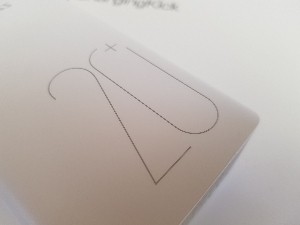
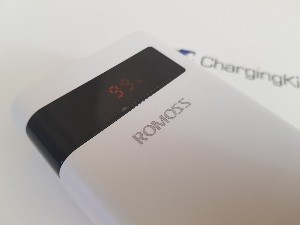

Pros & Cons:
Pros:
Sleek design
Great and useful battery screen indicator
Fast-charging speed
High battery efficiency
5 USB ports
Cons:
Heavier than an average big power bank
An average simultaneous charging time
No cable included
Rating
Power & Performance (1 to 5 stars)
Design & Build (1 to 5 stars)
Technology (1 to 5 stars)
Overall Rating (average of above)
Key Product Specifications
Key Specs:
Capacity
20,000 mAh / 74 Wh
Dimensions (LxWxH)
5.7 x 2.7 x 1.1 in / 14.5 x 6.9 x 2.8 cm
Weight
15.6 oz / 442 g
Output & Input Charging:
Average Charging Time of a Mobile Phone (average battery capacity 3000mAh)
1 hour and 20 minutes
Average Recharging Time (from 0% to 100%)
Standard charging: 9 hours
Fast charging: 6 hours and 30 minutes
Ports
- USB-A Output: 5V/2.1A
- USB-A Output (fast charging): 5V/3A, 9V/2A, 12V/1.5A
- USB-C Output (fast charging): 5V/3A, 9V/2A, 12V/1.5A
- USB-C Input: 5V/2A, 9V/2A (fast charging)
- Micro USB Input: 5V/2A, 9V/2A (fast charging)
- Lightning Input: 5V/2.1A
Charging Technology
- Fast Charging Technology
- Charging up to three devices simultaneously
Flight Status
Under 100 Wh
Safe to take on board.
Other Features
- 12 months warranty
Ideal For?
- Travelers
- Students
- Businesspeople
- Adventurers
What’s Inside?
- ROMOSS Power Bank 20000 mAh
- User Manual
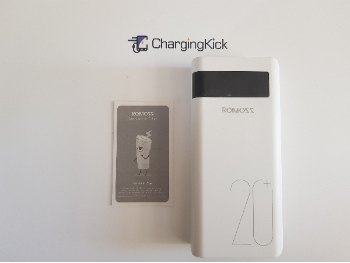
Power & Performance
Battery Capacity
Battery capacity in mAh and Watts
The ROMOSS power bank has a sizable battery of 20,000 mAh / 74 Wh. This significant battery is sufficient to charge most big phones at least 4 times, smaller might get over 6 times.
Capacity test: discharge the fully charged power bank
Have you ever wondered whether a power bank has its battery capacity? Does it really have 5,000 mAh or 10,000 mAh, as advertised? What is the real battery capacity?
To check the actual battery capacity we need:
The fully charged power bank
A USB tester that shows the current, voltage, mAh, and charging time.
The USB mini adjustable load receives energy from the power bank and releases it safely via the fan. This is the safe way to discharge a fully charged power bank and measure the real battery capacity.
I connect the dummy load (amperes are set to 2) to the USB tester, then plug it into the fully charged power bank. Once that’s done, I wait until the power bank’s battery goes flat. The screen on the USB tester will display the Watt-hours and the amount of mAh consumed. These data show the real battery capacity.
Using the aforementioned procedure, I tested the ROMOSS 20000 Power Bank. Here are the results:
Capacity Test

Results:
Discharge Time - 6 hours and 32 minutes
Watt-Hours - 69.2 Wh
Ampere hour - 13,662 mAh
The real battery capacity is 13,622 mAh. This mAh measurement shows you the energy you will fully use to charge your mobile phone. It’s not 20,000 mAh because the unit is converting energy from 3.7V (the power bank’s battery voltage) to 5V (USB voltage). This loss occurs in every power bank.
When you know the advertised and real battery capacity, it’s possible to measure the battery efficiency, which in this case is 92%. Manufacturers frequently don’t share this information. Efficiency above 90% is considered very good. With this result, this power bank is ahead of the pack.
Disclaimer: Every test can produce different results, but only small variations.
How many times can you charge the most popular mobile phones in 2020?
To put the battery capacity into perspective, I will use a formula for Real Battery Capacity and calculate how many times the ROMOSS Power Bank 20000 can charge the top 10 most popular mobile phones in 2020. Perhaps you own one of them, or at least you know your mobile phone’s battery capacity.
From the previous test, we know the real battery capacity is 13,622 mAh.
Once we know the real battery capacity, we simply divide it by the enlisted mobile phones’ battery capacity to find out how many times it can be charged.
Mobile Phone Model | How Many Times Can It Be Charged? |
4.61 | |
3.05 | |
2.88 | |
2.88 | |
3.24 | |
7.13 | |
2.88 | |
4.13 | |
3.09 | |
2.60 |
The tested portable charger can easily charge the biggest mobile phones at least 3 times, closer to 4, since we rarely let our phones die. Whereas phones should get full charge at least 5 times, if not 6.
Output Charging
Charging Time & Power Usage
Power banks are used mainly to charge devices. Therefore, this review would not be completed without testing output charging. For this, knowledge of the device’s charging time is crucial. Frequently it is one of the most important factors in the purchase of a power bank.
For these tests, I used two mobile phones:
Huawei P10 with a battery of 3200 mAh (Huawei SuperCharge)
Samsung S8 with a battery of 3000mAh (Adaptive Fast Charging)
Both phones support fast-charging technology.
To record data (current, voltage, mAh, time) I used a USB tester.
ROMOSS spoil with options. Two USB-A ports, one with standard charging and another with fast-charging speed. On top of this there is a USB-C port that allows fast-charging. Brilliant! Either you use USB-A or USB-C you should charge any compatible phone significantly faster than any other power bank. With three output ports, you can charge even three devices simultaneously - this is big! However, it’s unlikely it will recharge them quickly. Let’s dive into the test results.
Charging via USB-A (Huawei)

1 hour and 24 minutes for a full charge! Fairly good result and fast-charging was detected. The USB tester doesn’t show the accurate mAh due to faster charging. However, watt-hour is correct which is 13.3 Wh. Knowing watt-hour, it’s possible to calculate mAh, which is 2,660 mAh.
Charging via USB-A (Samsung)
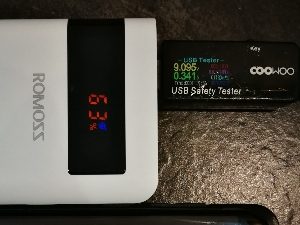
1 hour and 20 minutes to charge the Samsung S8! Another great result, and again fast-charging was detected. Again, the USB tester doesn’t show the correct mAh. Watt-hour is 10,7 Wh, it translates to 2,140 mAh.
Charging two phones simultaneously
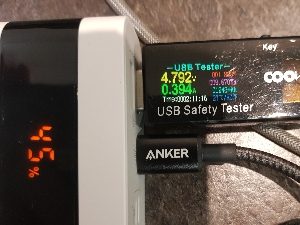
2 hours and 11 minutes to charge the Samsung S8 and Huawei P10. It’s an acceptable time, but expectations were higher. It seems the power bank charges more to the speed of three power banks, not two. Due to the layout, I couldn’t use two USB testers. The phones received roughly 4,400 mAh / 22 Wh in total.
Roundup of output charging
The manufacturer actually made a damn good power bank! I had some concerns that this is another “too good to be true” power bank, but it meets the expectations. It provides great charging time for individual phones. However, there is still improvement for simultaneous charging.
Input Charging
Recharging of this power bank is what stands out. There are three ways to recharge this device - via USB-C, Lightning or Micro USB. Great versatility, that allows you to use one cable to charge your phone and the same cable can be used to recharge the power bank. No more multiple cables. In terms of speed, both Micro USB and USB-C provide fast charging speed, whereas Lightning only has a standard charging speed.
I charged the power bank twice. The first test, via a standard charger rated at 5V/2A charging speed; a charger most of us have. For the second charge, I used the charger rated 65W, the fastest type of charger, able to charge compatible laptops.
Recharging via standard charger
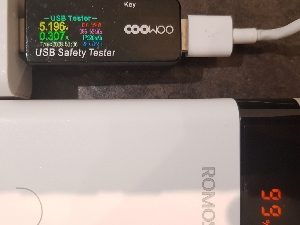
It took 8 hours and 54 minutes to charge the power bank to 100%. It’s a fairly good time for a standard charger. It can be easily recharged overnight. The power bank received 17,200 mAh / 86.6 Wh in total.
Recharging via Fast Charger
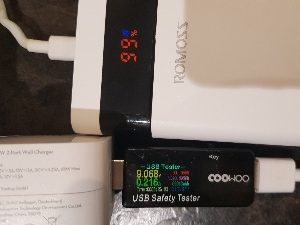
The power bank was charged in 6 hours and 26 minutes! It’s an excellent time! There are only a few big power banks that can be charged close to 6 hours. The fast charging speed was detected, hence the data are not accurate. The power bank received 18,180 mAh / 90.9 Wh.
Roundup of input charging
The ROMOSS didn’t disappoint. Recharging a big power bank in a bit more than 6 hours is a great accomplishment. For someone like me who hikes and travels, and needs a fast-charging while eating lunch in a pub, this short stay allows me to charge enough juice for a whole day if not longer. I bet many people can relate to it.
Score
Design & Build
Dimension & Weight
Weight in ounces and grams
- 15.6 oz / 442 g
Measurement in inches and centimeters
- 5.7 x 2.7 x 1.1 in / 14.5 x 6.9 x 2.8 cm
It’s slightly smaller than most big power banks, but significantly thicker. Big portable chargers are already thick, and anything thicker makes it difficult to keep in a pocket while charging a mobile phone. On top of this, it’s one of the heaviest power banks available. You can find power banks 2-3 ounces (50-80 grams) lighter than this power bank.
Design & Material
I truly love the design of this power bank. With all power banks I am fortunate to review, I was so excited to have it in my hand.
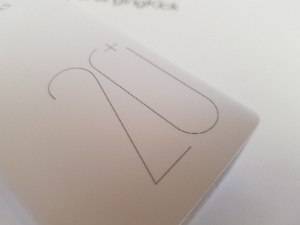
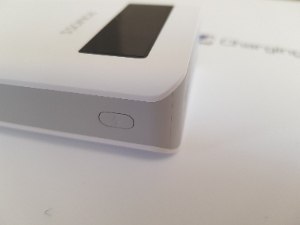
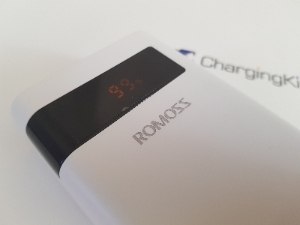
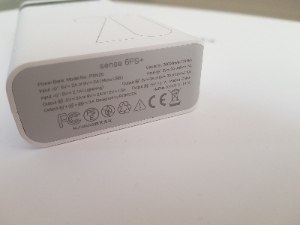
While most power banks are black, its white color stands out from the crowd. The big number “20+” on the front shows we are dealing here with a big gun. It has a plain surface, nice in touch, but it could be slightly coarse to improve grip. Although, curved edges not only look nice, but also improve the grip.
On the top of the power bank is a screen with a battery indicator. Four LED lights aren’t accurate enough in such a big battery, luckily ROMOSS is different. It shows precisely the remaining battery and if you press a power button, which is located on the side, it presents Voltage and Ampere, two main units responsible for charging speed. Once fast-charging is detected, a small blue bolt pops out on the screen. Small things, but make life way much easier.
Ports are on the top edge. There is enough space to plug up to three cables without tangling them out. Next to each port, there are small symbols that represent charging speed. The key can be found on the bottom edge, with all technical information.
Overall, it's an amazingly looking device. Packaged with ports, amazing battery screen and solid construction. The downside is dimension and weight, but this is the price for these extra features that make your life easier.
Score
Technology
Ports
The USB ports are what make this device so versatile. Three ports can be used to charge external devices, and the same amount to charge the power bank itself. The USB-C port can be used for both charging and recharging. You can charge up to three devices simultaneously, which is great for holiday and outing with friends. Additionally, one cable, whichever you use, will be enough to charge your mobile phone and recharge the power bank. Isn’t it great?
- USB-A Output: 5V/2.1A
- USB-A Output (fast charging): 5V/3A, 9V/2A, 12V/1.5A
- USB-C Output (fast charging): 5V/3A, 9V/2A, 12V/1.5A
- USB-C Input: 5V/2A, 9V/2A (fast charging)
- Micro USB Input: 5V/2A, 9V/2A (fast charging)
- Lightning Input: 5V/2.1A
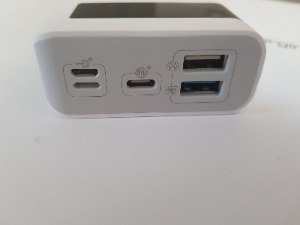
Tech
The manufacturer doesn’t enlist any well-known technology such as QuickCharge or any self-made technology. Many people could be sceptical. However, the tests show the performance of this power bank, which easily overtake many batteries with fancy technologies. Well done!
Score
Conclusion
Overall Opinion
ROMOSS shows us and its competitors how to create a powerful power bank, full of useful features and astonishing design. With the five USB ports and battery screen indicator, it beats most of the big power banks. It’s slightly too heavy, but it’s a small flaw. If you are looking for a versatile and powerful power bank for a reasonable price, you don’t have to look anymore.